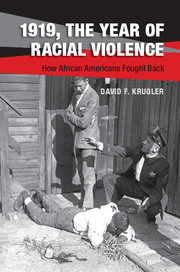Book contents
- Frontmatter
- Dedication
- Contents
- Acknowledgments
- Source Abbreviations and Usage Note
- Introduction
- 1 World War I and the New Negro Movement
- 2 “We Return Fighting”
- 3 Fighting a Mob in Uniform
- 4 Blood in the Streets
- 5 Armed Resistance to the Courthouse Mobs
- 6 Armed Resistance to Economic Exploitation in Arkansas, Indiana, and Louisiana
- 7 “It Is My Only Protection”
- 8 The Fight for Justice
- 9 The Fight for Justice
- 10 Fighting Judge Lynch
- Conclusion
- Bibliography
- Index
7 - “It Is My Only Protection”
Federal and State Efforts to Disarm African Americans
Published online by Cambridge University Press: 05 December 2014
- Frontmatter
- Dedication
- Contents
- Acknowledgments
- Source Abbreviations and Usage Note
- Introduction
- 1 World War I and the New Negro Movement
- 2 “We Return Fighting”
- 3 Fighting a Mob in Uniform
- 4 Blood in the Streets
- 5 Armed Resistance to the Courthouse Mobs
- 6 Armed Resistance to Economic Exploitation in Arkansas, Indiana, and Louisiana
- 7 “It Is My Only Protection”
- 8 The Fight for Justice
- 9 The Fight for Justice
- 10 Fighting Judge Lynch
- Conclusion
- Bibliography
- Index
Summary
On July 31, 1919, Major Walter H. Loving of the army’s Military Intelligence Division (MID) went to 135th Street and Lenox Avenue in Harlem to watch people buy newspapers at the corner’s four newsstands. Washington’s riot had ended ten days earlier, while Chicago’s still raged, and Loving wanted to know how closely New Yorkers were following the events. What he saw greatly impressed him. Eager readers snapped up new editions as soon as they arrived, thousands of copies selling within ten minutes. “People, white and black, actually scramble to get these papers,” he marveled, and the “bigger and more sensational the headlines, the quicker the paper is sold.” Loving worried that New York was on the brink of its own race riot. “Never before have the Negroes of Harlem been so worked up over anything as they are at present over the recent race riot in Washington and the present one in Chicago,” he remarked ominously.
Loving was not exaggerating New York’s racial tensions. Late on the night of July 19, an argument between two men – one black, the other white – almost led to a riot in Harlem. According to the New York Times, when the white man disputed something the black man said, the latter drew a handgun and fired five shots, wounding two bystanders. By the time a police captain and fifteen officers arrived, “several thousand excited negroes” had filled 127th Street between Second and Third Avenues. When the police dispersed the crowd and began searching houses for “persons believed to have been concerned in the riot,” someone opened fire on them. On July 22, a black man stabbed a white man who had slapped a black woman in a subway car. That same day, a white soldier ordered a black man to give up his seat aboard an elevated train. When he refused, the soldier tried to pull him to his feet, and only the conductor’s intervention prevented a fight from breaking out. Another white soldier stood outside a Harlem theater, spewing racist invective, until the police made him stop. “The least little cause is likely to start a riot,” Loving warned.
- Type
- Chapter
- Information
- 1919, The Year of Racial ViolenceHow African Americans Fought Back, pp. 196 - 212Publisher: Cambridge University PressPrint publication year: 2014



